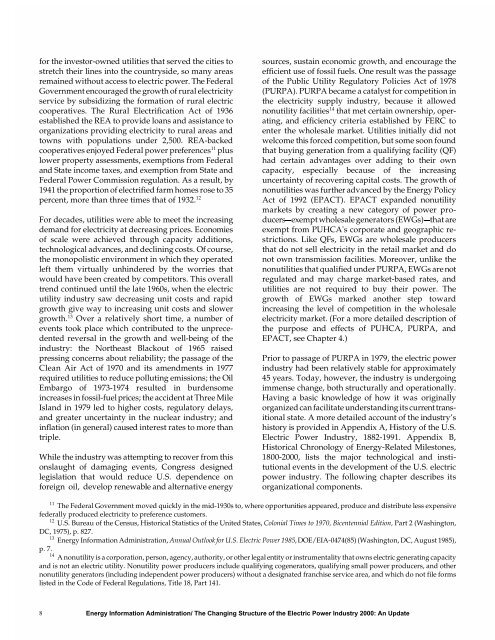The Changing Structure of the Electric Power Industry 2000: An ... - EIA
The Changing Structure of the Electric Power Industry 2000: An ... - EIA
The Changing Structure of the Electric Power Industry 2000: An ... - EIA
Create successful ePaper yourself
Turn your PDF publications into a flip-book with our unique Google optimized e-Paper software.
for <strong>the</strong> investor-owned utilities that served <strong>the</strong> cities to<br />
stretch <strong>the</strong>ir lines into <strong>the</strong> countryside, so many areas<br />
remained without access to electric power. <strong>The</strong> Federal<br />
Government encouraged <strong>the</strong> growth <strong>of</strong> rural electricity<br />
service by subsidizing <strong>the</strong> formation <strong>of</strong> rural electric<br />
cooperatives. <strong>The</strong> Rural Electrification Act <strong>of</strong> 1936<br />
established <strong>the</strong> REA to provide loans and assistance to<br />
organizations providing electricity to rural areas and<br />
towns with populations under 2,500. REA-backed<br />
cooperatives enjoyed Federal power preferences 11 plus<br />
lower property assessments, exemptions from Federal<br />
and State income taxes, and exemption from State and<br />
Federal <strong>Power</strong> Commission regulation. As a result, by<br />
1941 <strong>the</strong> proportion <strong>of</strong> electrified farm homes rose to 35<br />
percent, more than three times that <strong>of</strong> 1932. 12<br />
For decades, utilities were able to meet <strong>the</strong> increasing<br />
demand for electricity at decreasing prices. Economies<br />
<strong>of</strong> scale were achieved through capacity additions,<br />
technological advances, and declining costs. Of course,<br />
<strong>the</strong> monopolistic environment in which <strong>the</strong>y operated<br />
left <strong>the</strong>m virtually unhindered by <strong>the</strong> worries that<br />
would have been created by competitors. This overall<br />
trend continued until <strong>the</strong> late 1960s, when <strong>the</strong> electric<br />
utility industry saw decreasing unit costs and rapid<br />
growth give way to increasing unit costs and slower<br />
growth. 13 Over a relatively short time, a number <strong>of</strong><br />
events took place which contributed to <strong>the</strong> unprecedented<br />
reversal in <strong>the</strong> growth and well-being <strong>of</strong> <strong>the</strong><br />
industry: <strong>the</strong> Nor<strong>the</strong>ast Blackout <strong>of</strong> 1965 raised<br />
pressing concerns about reliability; <strong>the</strong> passage <strong>of</strong> <strong>the</strong><br />
Clean Air Act <strong>of</strong> 1970 and its amendments in 1977<br />
required utilities to reduce polluting emissions; <strong>the</strong> Oil<br />
Embargo <strong>of</strong> 1973-1974 resulted in burdensome<br />
increases in fossil-fuel prices; <strong>the</strong> accident at Three Mile<br />
Island in 1979 led to higher costs, regulatory delays,<br />
and greater uncertainty in <strong>the</strong> nuclear industry; and<br />
inflation (in general) caused interest rates to more than<br />
triple.<br />
While <strong>the</strong> industry was attempting to recover from this<br />
onslaught <strong>of</strong> damaging events, Congress designed<br />
legislation that would reduce U.S. dependence on<br />
foreign oil, develop renewable and alternative energy<br />
11<br />
<strong>The</strong> Federal Government moved quickly in <strong>the</strong> mid-1930s to, where opportunities appeared, produce and distribute less expensive<br />
federally produced electricity to preference customers.<br />
12<br />
U.S. Bureau <strong>of</strong> <strong>the</strong> Census, Historical Statistics <strong>of</strong> <strong>the</strong> United States, Colonial Times to 1970, Bicentennial Edition, Part 2 (Washington,<br />
DC, 1975), p. 827.<br />
13<br />
Energy Information Administration, <strong>An</strong>nual Outlook for U.S. <strong>Electric</strong> <strong>Power</strong> 1985, DOE/<strong>EIA</strong>-0474(85) (Washington, DC, August 1985),<br />
p. 7.<br />
14<br />
A nonutility is a corporation, person, agency, authority, or o<strong>the</strong>r legal entity or instrumentality that owns electric generating capacity<br />
and is not an electric utility. Nonutility power producers include qualifying cogenerators, qualifying small power producers, and o<strong>the</strong>r<br />
nonutility generators (including independent power producers) without a designated franchise service area, and which do not file forms<br />
listed in <strong>the</strong> Code <strong>of</strong> Federal Regulations, Title 18, Part 141.<br />
8<br />
sources, sustain economic growth, and encourage <strong>the</strong><br />
efficient use <strong>of</strong> fossil fuels. One result was <strong>the</strong> passage<br />
<strong>of</strong> <strong>the</strong> Public Utility Regulatory Policies Act <strong>of</strong> 1978<br />
(PURPA). PURPA became a catalyst for competition in<br />
<strong>the</strong> electricity supply industry, because it allowed<br />
nonutility facilities 14 that met certain ownership, operating,<br />
and efficiency criteria established by FERC to<br />
enter <strong>the</strong> wholesale market. Utilities initially did not<br />
welcome this forced competition, but some soon found<br />
that buying generation from a qualifying facility (QF)<br />
had certain advantages over adding to <strong>the</strong>ir own<br />
capacity, especially because <strong>of</strong> <strong>the</strong> increasing<br />
uncertainty <strong>of</strong> recovering capital costs. <strong>The</strong> growth <strong>of</strong><br />
nonutilities was fur<strong>the</strong>r advanced by <strong>the</strong> Energy Policy<br />
Act <strong>of</strong> 1992 (EPACT). EPACT expanded nonutility<br />
markets by creating a new category <strong>of</strong> power producers�exempt<br />
wholesale generators (EWGs)�that are<br />
exempt from PUHCA's corporate and geographic restrictions.<br />
Like QFs, EWGs are wholesale producers<br />
that do not sell electricity in <strong>the</strong> retail market and do<br />
not own transmission facilities. Moreover, unlike <strong>the</strong><br />
nonutilities that qualified under PURPA, EWGs are not<br />
regulated and may charge market-based rates, and<br />
utilities are not required to buy <strong>the</strong>ir power. <strong>The</strong><br />
growth <strong>of</strong> EWGs marked ano<strong>the</strong>r step toward<br />
increasing <strong>the</strong> level <strong>of</strong> competition in <strong>the</strong> wholesale<br />
electricity market. (For a more detailed description <strong>of</strong><br />
<strong>the</strong> purpose and effects <strong>of</strong> PUHCA, PURPA, and<br />
EPACT, see Chapter 4.)<br />
Prior to passage <strong>of</strong> PURPA in 1979, <strong>the</strong> electric power<br />
industry had been relatively stable for approximately<br />
45 years. Today, however, <strong>the</strong> industry is undergoing<br />
immense change, both structurally and operationally.<br />
Having a basic knowledge <strong>of</strong> how it was originally<br />
organized can facilitate understanding its current transitional<br />
state. A more detailed account <strong>of</strong> <strong>the</strong> industry’s<br />
history is provided in Appendix A, History <strong>of</strong> <strong>the</strong> U.S.<br />
<strong>Electric</strong> <strong>Power</strong> <strong>Industry</strong>, 1882-1991. Appendix B,<br />
Historical Chronology <strong>of</strong> Energy-Related Milestones,<br />
1800-<strong>2000</strong>, lists <strong>the</strong> major technological and institutional<br />
events in <strong>the</strong> development <strong>of</strong> <strong>the</strong> U.S. electric<br />
power industry. <strong>The</strong> following chapter describes its<br />
organizational components.<br />
Energy Information Administration/ <strong>The</strong> <strong>Changing</strong> <strong>Structure</strong> <strong>of</strong> <strong>the</strong> <strong>Electric</strong> <strong>Power</strong> <strong>Industry</strong> <strong>2000</strong>: <strong>An</strong> Update

















